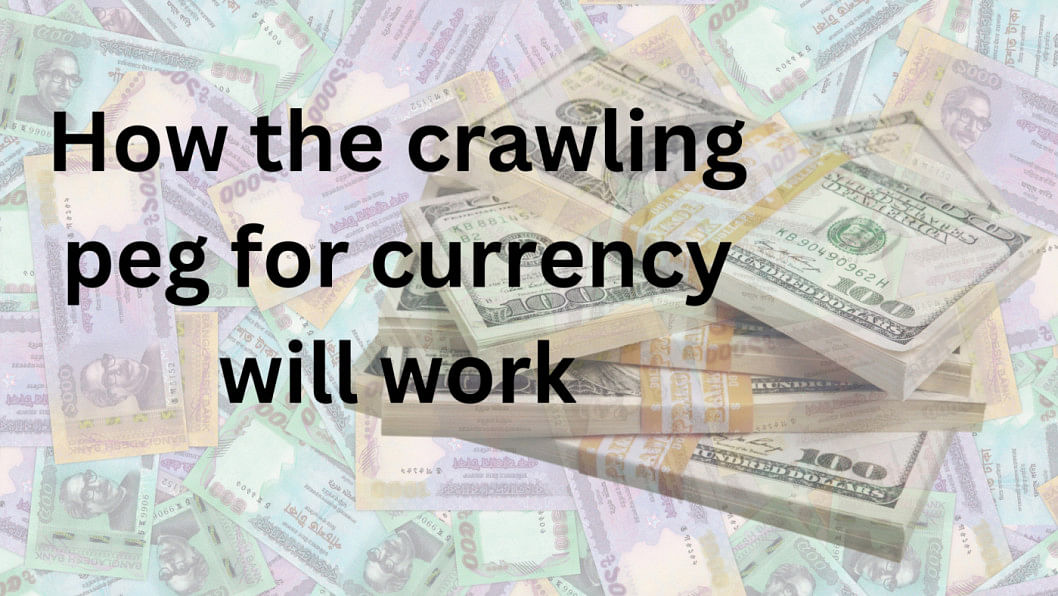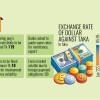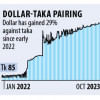How the crawling peg for currency will work

The central bank has rolled out a plan to introduce an interim crawling peg system for the taka to regulate abrupt fluctuations of its value, paving the way towards a fully flexible regime in the future.
The system will be tethered to a carefully chosen basket of currencies within a defined band corridor, Bangladesh Bank said in a monetary policy statement yesterday.
A "competitive and representative equilibrium" rate will be established at the midpoint of the corridor, allowing the exchange rate flexibility within these bounds.
And Bangladesh Bank will retain its authority to intervene in the currency market to prevent the exchange rate from breaching the limits.
The new interim measure is a departure from the central bank's earlier promise.
In June last year, Bangladesh Bank pledged to allow the currency to float freely for the first time in Bangladesh's history, a key demand from the International Monetary Fund to keep a $4.7 billion loan programme on track.
Since mid-2022, the taka has been depreciating against the dollar, a trend primarily attributed to a balance of payments deficit leading to a significant reduction in foreign exchange reserves over the year.
The weakening of the taka is also blamed for the domestic inflation shock, as the cost of imports has risen.
The central bank came under pressure for a gradual shift towards a market-based exchange rate system.
This transition was advocated to stabilise the exchange rate and prevent further depletion of the country's foreign exchange reserves.
The crawling peg system is "aimed at tempering unusual fluctuations in the currency's value", the central bank said.
The crawling peg is a system of exchange rate adjustments in which a currency with a fixed exchange rate is allowed to fluctuate within a band of rates.
The method fully uses the key attributes of the fixed exchange regime, as well as the flexibility of the floating exchange rate regime.
Currently, only three countries -- Botswana, Honduras, and Nicaragua – use a crawling peg, according to the International Monetary Fund.
In 2022, some 13.4 percent of the IMF members used the hard peg, 46.9 percent the soft peg, which includes the countries using the crawling peg, and 34 percent floating exchange rates.
Crawling pegs are often used to control currency moves when there is a threat of devaluation due to factors such as inflation or economic instability, said the IMF.
At the same time, maintaining a crawling peg imposes constraints on monetary policy like a fixed peg system, it said.
Bangladesh is one of 24 nations that follow crawl-like arrangements. Other nations include Algeria, Gambia, Kenya and Sri Lanka, according to an IMF report.
Bangladesh's foreign exchange regime has been facing serious volatility for the past two years, with the stock of forex reserves halving and the taka losing its value by about 28 percent.
The reserves stood at $20.18 billion on January 10, compared with $40.7 billion in August 2021.
Currently, Bangladesh Foreign Exchange Dealers Association and Association of Bankers, Bangladesh are fixing the dollar rate. Experts say the rate-setting model is not working.
For the second half of this fiscal year, Bangladesh Bank's strategic directives are centred on "upholding a vigilant, hawkish approach to monetary policy until inflation rates are effectively reined into a desired level".
Selim RF Hussain, chairman of the Association of Bankers, Bangladesh, said the BB introduced the new concept of crawling peg to formally manage the exchange rate.
"This would be a relatively transparent mechanism and much more aligned with the market. It would establish transparency and bring stability in the forex market. We expect that the BB would enforce its rule properly," said Hussain, also managing director and chief executive at BRAC Bank.
Naser Ezaz Bijoy, chief executive officer of Standard Chartered Bangladesh, said, "We need to wait for details of construct of the benchmark or reference rate. However, it is clear that the intention is to move to a market-based rate over time and this is a step in the right direction."
"This framework is expected to be transparent and credible," he said.
Since this framework would be implemented by the BB itself, it can create a legally binding obligation for compliance on the commercial banks, Naser said.
"Hence, punitive measures can be enforced on non-compliance with(out) any legal challenges. We shall be looking forward to the early implementation of such a framework which will have better reflection of the market and enforcement of punitive measures against non-compliance," he said.

 For all latest news, follow The Daily Star's Google News channel.
For all latest news, follow The Daily Star's Google News channel. 








Comments